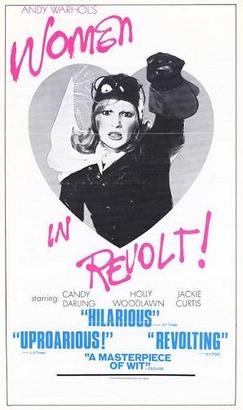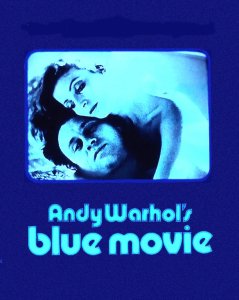Related Research Articles

Andy Warhol was an American visual artist, film director, and producer who was a leading figure in the visual art movement known as pop art. His works explore the relationship between artistic expression, advertising, and celebrity culture that flourished by the 1960s, and span a variety of media, including painting, silkscreening, photography, film, and sculpture. Some of his best-known works include the silkscreen paintings Campbell's Soup Cans (1962) and Marilyn Diptych (1962), the experimental films Empire (1964) and Chelsea Girls (1966), and the multimedia events known as the Exploding Plastic Inevitable (1966–67).

Batman Dracula is a 1964 black and white American superhero fan film produced and directed by Andy Warhol without the permission of DC Comics, who owns the character Batman.

The Factory was Andy Warhol's studio in New York City, which had four locations between 1963 and 1987. The Factory became famed for its parties in the 1960s. It was the hip hangout spot for artists, musicians, celebrities and Warhol's superstars. The original Factory was often referred to as the Silver Factory. In the studio, Warhol's workers would make silkscreens and lithographs under his direction.

Robert Indiana was an American artist associated with the pop art movement.
Blow Job is a silent film directed by Andy Warhol. It depicts the face of an uncredited DeVeren Bookwalter as he apparently receives fellatio from an unseen partner. While shot at 24 frames per second, Warhol specified that it should be projected at 16 frames per second, slowing it down by a third.
Film Culture was an American film magazine started by Adolfas Mekas and his brother Jonas Mekas in 1954. The publication's headquarters were in New York City. Best known for exploring the avant-garde cinema in depth, it also published articles on other aspects of cinema, including Hollywood films.

Women in Revolt is a 1971 American satirical film produced by Andy Warhol and directed by Paul Morrissey. The film stars Jackie Curtis, Candy Darling, and Holly Woodlawn, three trans women and superstars of Warhol's Factory scene. It also features soundtrack music by John Cale.

The Institute of Contemporary Art or ICA is a contemporary art museum in Philadelphia. The museum is associated with the University of Pennsylvania, and is located on its campus. The Institute is one of the country's leading museums dedicated to exhibiting the innovative art of our time. Robert Chaney is its Director of Curatorial Affairs.

Blue Movie is a 1969 American erotic film written, produced and directed by Andy Warhol. It is the first adult erotic film depicting explicit sex to receive wide theatrical release in the United States, and is regarded as a seminal film in the Golden Age of Porn. It helped inaugurate the "porno chic" phenomenon, in which porn was publicly discussed by celebrities and taken seriously by film critics, in modern American culture, and later, in many other countries throughout the world. According to Warhol, Blue Movie was a major influence in the making of Last Tango in Paris, an internationally controversial erotic drama film starring Marlon Brando and released a few years after Blue Movie was made. Viva and Louis Waldon, playing themselves, starred in Blue Movie.

Lonesome Cowboys is a 1968 American Western film directed by Andy Warhol and written and produced by Paul Morrissey. The film is a satire of Hollywood Westerns, and was initially screened in November 1968 at the San Francisco International Film Festival, where it won the Best Film Award. On May 5, 1969, it was shown for initial viewings at the New Andy Warhol Garrick Theatre in New York City.
Sleep is a 1964 American avant-garde film by Andy Warhol. Lasting five hours and 20 minutes, it consists of looped footage of John Giorno, Warhol's lover at the time, sleeping.
Eating Too Fast is a 1966 Andy Warhol film made at The Factory. It was originally titled Blow Job #2 and features art critic and writer Gregory Battcock (1937–1980). The film is 67 minutes long and is, in effect, a black and white sound film remake of Warhol's Blow Job (1964). Battcock had previously appeared in Warhol's films Batman Dracula (1964) and Horse (1965).
Four Stars is a 1967 avant-garde film by Andy Warhol, actually consisting of 25 hours of film. In typical Warhol fashion of the period, each reel of the film is 35 minutes long, or 1200 ft. in length, and is shot in sync-sound.
Kiss is a 1963 silent American experimental film directed by Andy Warhol, which runs 50 minutes and features various couples – man and woman, woman and woman, man and man – kissing for 3½ minutes each. The film features Naomi Levine, Barbara Rubin, Gerard Malanga, Rufus Collins, Johnny Dodd, Ed Sanders, Mark Lancaster, Fred Herko, Baby Jane Holzer, Robert Indiana, Andrew Meyer, John Palmer, Pierre Restany, Harold Stevenson, Philip van Rensselaer, Charlotte Gilbertson, Marisol, Steven Holden, and unidentified others.
Thirteen Most Wanted Men was a large mural created by Andy Warhol for the New York State Pavilion at the 1964 World's Fair at Flushing Meadows, New York. The mural was painted over with silver paint before the fair opened, probably due to official objections, but other reasons have been suggested.
Bike Boy is a 1967 American avant garde film directed by Andy Warhol, and was shown, for initial viewings, at the New Andy Warhol Garrick Theatre, at 152 Bleecker Street, Manhattan, New York City. The film has a bit part by Valerie Solanas.
Harlot is a 1964 American underground film directed by Andy Warhol, written by Ronald Tavel, and featuring Mario Montez lounging on a sofa, eating bananas, with Gerard Malanga in a tuxedo, and with Tavel, Billy Name, and Harry Fainlight having an off-screen discussion. This was Warhol's first sync-sound movie, filmed in December 1964 with his new Auricon camera.
Henry Geldzahler (1964) is a feature-length underground film directed by Andy Warhol, featuring art curator Henry Geldzahler smoking a cigar and becoming increasingly uncomfortable for 97 minutes. The film was shot silent and in black-and-white in the first week of July 1964, using unused film left from the filming of Empire.
Soap Opera, subtitled The Lester Persky Story, is a 1964 feature-length underground film directed by Andy Warhol, starring Baby Jane Holzer, and featuring Gerard Malanga, Sam Green, and Ivy Nicholson. The subtitle was used by Warhol since he used old television advertisement footage provided by Lester Persky.
Couch (1964) is a feature-length underground film directed by Andy Warhol, and starring Gerard Malanga, Piero Heliczer, Naomi Levine, Gregory Corso, Allen Ginsberg, John Palmer, Baby Jane Holzer, Ivy Nicholson, Amy Taubin, Ondine, Peter Orlovsky, Jack Kerouac, Taylor Mead, Kate Heliczer, Rufus Collins, Joseph LeSeuer, Binghamton Birdie, Mark Lancaster, Gloria Wood, and Billy Name.
References
- ↑ WarholStars entry
- ↑ Blake Gopnik, Warhol: A Life as Art London: Allen Lane. March 5, 2020. ISBN 978-0-241-00338-1 p. 415